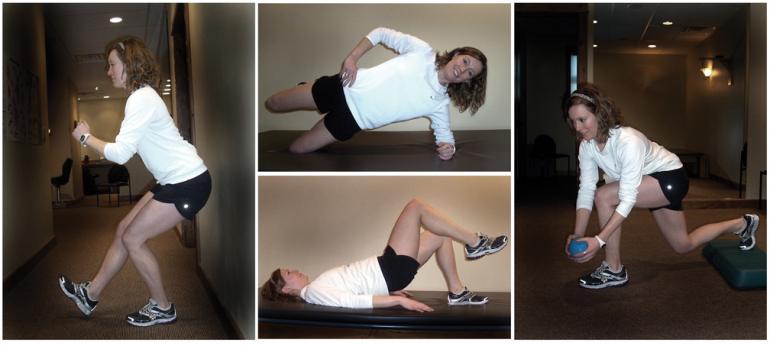Hip Check
Running injuries are very common—up to 60% of runners get one while training or racing. Most of the time, the injuries are damage that occurs due to repetitive stress. After all, a typical runner takes over 5,000 steps during a 30-minute run, and that may interact with underlying muscular imbalances and faulty mechanics, leading to the breakdown of tendons, joints, or even bones, creating an injury. What's worse, the recovery is often delayed—even if the runner takes time off. That's why many running injuries create chronic pain.
How well our bodies adapt to the stress of running depends on our strength, gait mechanics, training schedule, and footwear. Hip strength is particularly important for controlling the mechanics of running. Often, just a few exercises can make a big impact on preventing running injuries and increasing performance. Here's what you can do two to three times a week to supplement your running.
1. Single-Leg Butt-to-Wall Squat
This exercise strengthens the same muscle groups but in a more functional manner. Stand with your feet hip-width apart, facing approximately two foot-lengths away from a wall. Initiate a squat by bending at the hip, letting your butt touch the wall (but do not use the wall as support) as you sink down into a squat. Maintain a level pelvis and keep your knee in line with your hip throughout the exercise. Perform two to three sets of ten to 15 repetitions on each leg.
2. Modified Side Plank
The modified side plank is a great exercise to strengthen weak hip abductors. Start by lying on your side with your knees bent. Keep your knees in line with your hips and your hips in line with your shoulders. Push through your downward elbow/shoulder and knee to lift your trunk off the mat. Lift your top leg and hold for 30 to 60 seconds. Switch to your other side and perform three repetitions on each side.
3. Marching Bridge
The gluteus maximus is the strongest hip external rotator and very important for maintaining proper running form. Lie on your back with your knees bent and your feet on the floor, hip-width apart. Gently contract your abdominals and use your buttocks to lift your pelvis off the mat. While maintaining a level pelvis, lift one foot a few inches off the mat. Alternate with the other leg. March back and forth ten to 20 times. Perform three to four sets.
4. Transverse Lunge
The transverse lunge focuses on controlling hip rotation and adduction to provide stability in the lower extremities. Stand on a step and lunge off at an anterolateral oblique angle. As you lunge, rotate your trunk to the outside of your leading leg. Return by pushing off your lead leg and stabilizing through your trailing leg. Maintain a level pelvis and good knee alignment through the exercise. Perform two to three sets of ten to 15 repetitions for each leg.
Jason Lunden is a board-certified sports physical therapy clinical specialist at Excel Physical Therapy in Bozeman. Check out his blog at excelptmt.com.












